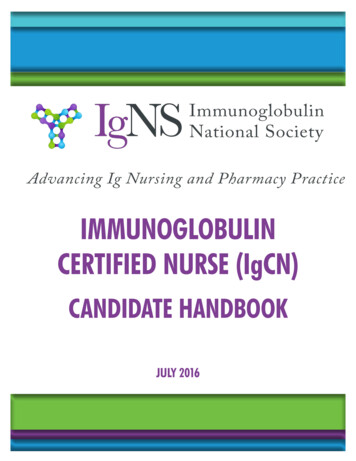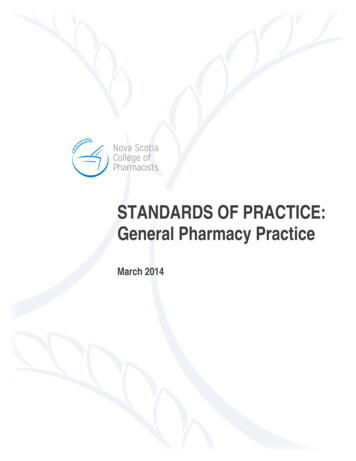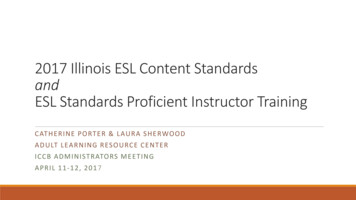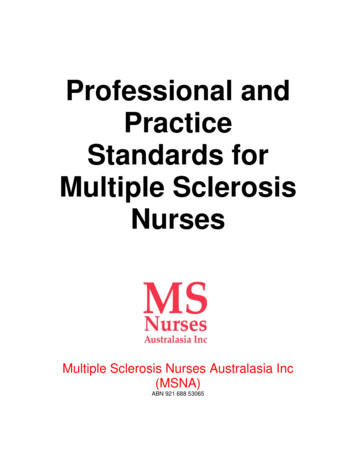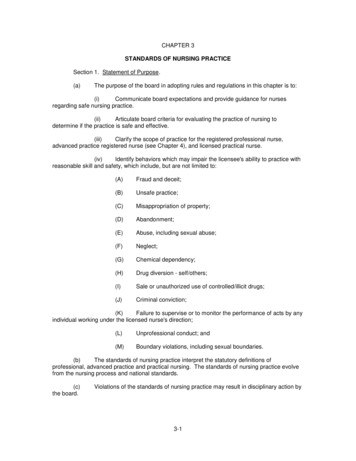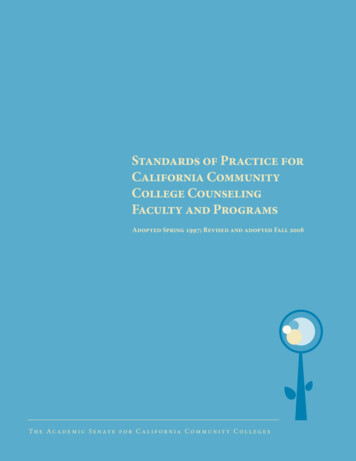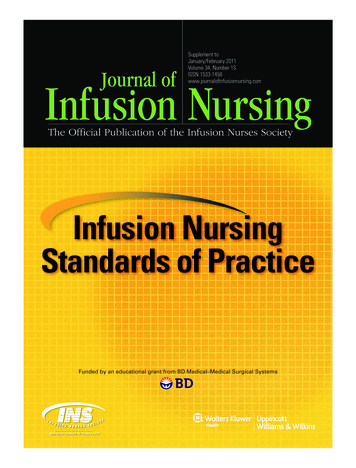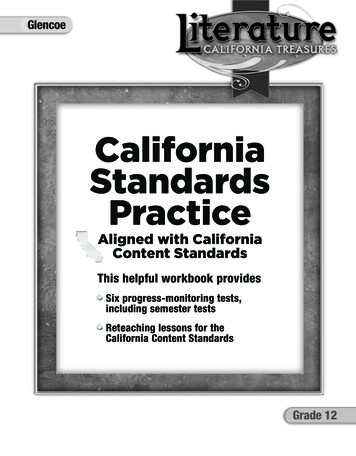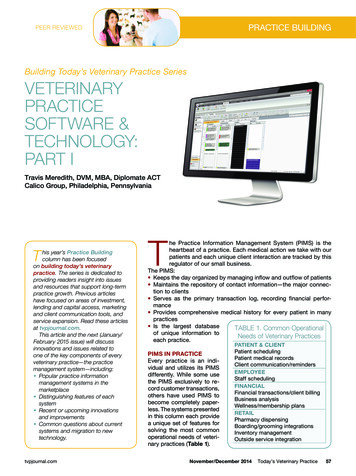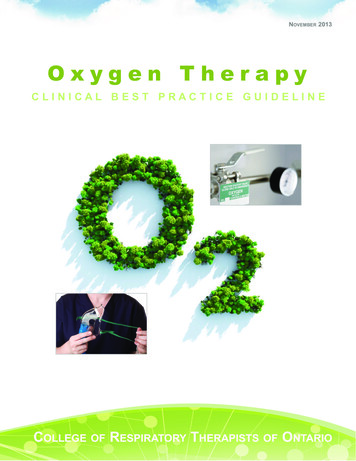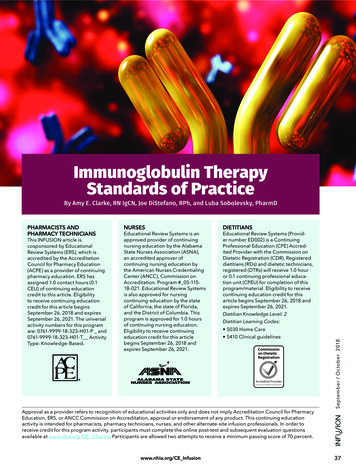
Transcription
Immunoglobulin TherapyStandards of PracticeBy Amy E. Clarke, RN IgCN, Joe DiStefano, RPh, and Luba Sobolevsky, PharmDThis INFUSION article iscosponsored by EducationalReview Systems (ERS), which isaccredited by the AccreditationCouncil for Pharmacy Education(ACPE) as a provider of continuingpharmacy education. ERS hasassigned 1.0 contact hours (0.1CEU) of continuing educationcredit to this article. Eligibilityto receive continuing educationcredit for this article beginsSeptember 26, 2018 and expiresSeptember 26, 2021. The universalactivity numbers for this programare: 0761-9999-18-323-H01-P and0761-9999-18-323-H01-T ActivityType: Knowledge-Based.NURSESDIETITIANSEducational Review Systems is anapproved provider of continuingnursing education by the AlabamaState Nurses Association (ASNA),an accredited approver ofcontinuing nursing education bythe American Nurses CredentialingCenter (ANCC), Commission onAccreditation. Program # 05-11518-021. Educational Review Systemsis also approved for nursingcontinuing education by the stateof California, the state of Florida,and the District of Columbia. Thisprogram is approved for 1.0 hoursof continuing nursing education.Eligibility to receive continuingeducation credit for this articlebegins September 26, 2018 andexpires September 26, 2021.Educational Review Systems (Provider number ED002) is a ContinuingProfessional Education (CPE) Accredited Provider with the Commission onDietetic Registration (CDR). Registereddietitians (RDs) and dietetic technicians,registered (DTRs) will receive 1.0 houror 0.1 continuing professional education unit (CPEU) for completion of thisprogram/material. Eligibility to receivecontinuing education credit for thisarticle begins September 26, 2018 andexpires September 26, 2021.Dietitian Knowledge Level: 2Dietitian Learning Codes: 5030 Home Care 5410 Clinical guidelinesSeptember / Oc tober 2018PHARMACISTS ANDPHARMACY TECHNICIANSApproval as a provider refers to recognition of educational activities only and does not imply Accreditation Council for PharmacyEducation, ERS, or ANCC Commission on Accreditation, approval or endorsement of any product. This continuing educationactivity is intended for pharmacists, pharmacy technicians, nurses, and other alternate-site infusion professionals. In order toreceive credit for this program activity, participants must complete the online post-test and subsequent evaluation questionsavailable at www.nhia.org/CE Infusion. Participants are allowed two attempts to receive a minimum passing score of 70 percent.www.nhia.org/CE Infusion37
Learning Objectives: Describe patient risk factors affecting Ig therapy Identify Ig product formulation factors affecting Ig therapy Review common IVIG adverse drug reactions and mitigation Discuss common SCIG adverse drug reactions and mitigationAUTHOR BIOS:September / Oc tober 2018Amy E. Clarke, RN IgCN, isDirector of Nursing ClinicalProgram Services, DiplomatPharmacy, Specialty InfusionGroup. She is a registered nurseand has been in the specialtyand home infusion arena since1994. She has done over 2,000intravenous and subcutaneousinfusions to date. She hashelped to educate nursing staff,pharmacists, payers, physicians,among others through multiplepresentations on IVIG andSCIG administration specifics,including continuing educationpresentations for the NationalHome Infusion Association(NHIA), Infusion Nursing Society(INS), and the ImmunoglobulinNational Society (IgNS). Amy iscurrently co-chair of the IgNSEducation Commitee and is theIgNS president emeritus for the2016-2018 term.38Joe DiStefano, RPh, isDirector of Clinical Programsat NuFactor SpecialtyPharmacy. He has thirtyyears of home infusion,clinical, and pharmacymanagement experienceand has specialized inimmune globulin therapyfor more than ten years.He is responsible forclinical program and toolsdevelopment, policy andprocedure development,quality improvement, andaccreditation. Joe holdsa Bachelor of Sciencedegree in Pharmacy fromNortheastern University inBoston, MA.AUTHOR DISCLOSURES STATEMENTThe authors have no conflicts of interest to disclose.www.nhia.org/CE InfusionLuba Sobolevsky, PharmD,is Executive Director,Immunoglobulin NationalSociety, the central healthcare organization in the fieldof Ig therapy. In this capacity,she oversees all areas of IgNS,including education, standardsof practice, certification,professional resources,development, advocacy, andalliances. She holds a Doctorof Pharmacy degree fromthe University of SouthernCalifornia, and has expertiseacross various sectors ofhealth care, including clinical,educational development, andpharmaceutical industry.
Any specialized clinical field requiresstandardization to ensure best clinicalpractice, assure health care professionalaccountability, and protect patients, clinicians,and organizations. The ImmunoglobulinNational Society (IgNS) has recently publishedthe second edition of the Ig Therapy Standardsof Practice, a set of guidelines that providea framework to support multidisciplinarypractices in defining and developing Igpolicies, procedures, and data collectionstrategies. IgNS is dedicated to advancinga multidisciplinary health care practiceapproach through comprehensive educationand professional certification for nurses (witha pharmacist certification underway). Theorganization promotes patient-centric advocacyinitiatives and provides critical practiceresources to clinicians and organizations.(2, 3)Ig therapy is used for replacement therapyin immunodeficiency diseases and forimmunomodulatory effects in autoimmune andinflammatory disorders. Sixteen Ig therapyproducts are currently available in the U.S.,with multiple new products in various stagesof development.(4, 8, 9, 10, 11, 12, 13, 14, 15, 16, 19, 20, 21, 22,23)While all Ig brands have been shown to beeffective in respective clinical trials, formulationdifferences and routes of administration areknown to significantly impact tolerability onan individual patient level. Ig products are notinterchangeable, and specific Ig products needto be matched to specific patient characteristicsto ensure patient safety. It is thus inappropriateto switch Ig products without careful anddue consideration, and substitution shouldonly occur with the active participation of thepatient, prescriber, and the health care team.In the event of a brand switch, an Ig-naiveadministration protocol should be initiated forthe first several infusions — until the patient’sindividual tolerability of the new brand isestablished.(3)Site of care options include hospital, infusionsuite, physician’s office, and the home setting.Considerations for safe at-home administrationinclude a patient or caregiver’s ability andmotivation to participate in care, provider’s andnurse’s specialized expertise and credentials,Ig standards-based protocols and policies,immediate access to emergency medicalservices, among other considerations.(3)Before initiating Ig therapy, the Ig clinicianshould conduct a thorough assessment thatincludes outlining the outcome goals, patient’shealth status and vital signs, hydration status,disease-specific assessments, previous Igregimen, risk factors and co-morbidities, aswell as any history of adverse drug reactions(ADRs). Access to preferred Ig brand and issueswith insurance coverage and payer formularyare important patient advocacy factors.(3)Risk Factors and ConsiderationsA thorough risk assessment including apatient’s individual health risk factors, Ig brandrisk factors, and other issues impacting successof therapy must be conducted ahead of everyinfusion.Patient risk factors relevant to Ig therapyselection include diabetes mellitus, fluidrestriction, cardiac and pulmonary function,blood type, age (especially neonates andgeriatrics), obesity, history of thrombosis, andrenal impairment/renal failure.Further, several class-labeled Boxed Warningsexist with Ig therapy. Renal dysfunctionand renal failure are class-labeled BoxedWarnings for intravenous immune globulin(IVIG), and are most often associated withsucrose-containing Ig preparations. The lastIg brand stabilized with sucrose (CarimuneNF, CSL Behring) is no longer produced andis not commercially available. Patients at riskfor renal dysfunction, renal failure, osmoticnephrosis, and death include those with preexisting renal insufficiency, diabetes mellitus,age greater than 65, volume depletion, sepsis,www.nhia.org/CE InfusionSeptember / Oc tober 2018BackgroundSince their first use in the 1950s,immunoglobulin (Ig) preparations haveevolved through sophisticated manufacturingprocesses, resulting in effective and safeproducts used in a variety of clinical indicationsand practice settings. Patient risk factors,product differences, dosing, appropriateadministration protocols, and emergencypreparedness are among the factors thatimpact patient safety, tolerability, adherence,and treatment success.(1)39
paraproteinemia, or patientsreceiving known nephrotoxicdrugs.Therapy Standards of Practice2nd Edition, Ig ProductConsiderations section.Thrombosis is another classlabeled Boxed Warningfor all IVIG as well assubcutaneous (SCIG) andfacilitated SCIG (fSCIG)formulations. Risk factorsmay include advanced age,prolonged immobilization,hypercoagulable conditions,history of venous orarterial thrombosis, use ofestrogens, indwelling vascularcatheters, hyperviscosity, andcardiovascular risk factors.IntravenousImmunoglobulin (IVIG)IVIG is typically given viaa peripherally insertedangiocatheter (the mostcommon method) or a centralline (such as an implantedport), and is administeredusing an infusion pump whichallows controlled titrationof rates and volumes. Thepharmacokinetic profileof the IV route allows fastabsorption and higher initialserum Ig peaks as comparedto SCIG and fSCIG. TheIVIG serum concentrationcontinues to decline over athree-four week period, whenthe next dose is administered.Due to its complexity, adverseevent profile, risk factors, andpotential for serious ADRs atevery infusion, regardless ofpatient experience or brand,IVIG must be administeredby a clinician who, per theIg Therapy Standards ofPractice, must remain withthe patient throughout theinfusion. (3,4,8-16,19-24)A patient’s medical historyand health status must beevaluated to determine theIg product(s) that may bemost suitable on an individualbasis. Clinicians are advisedto review the IgNS Ig TherapyStandards of Practice 2ndEdition, Ig Treatment Planningsection for further information.September / Oc tober 2018(3-6, 8-24)40Ig Product Risk FactorsIg product formulations differin route of administration,concentration, osmolality,stabilizers, sodium, IgAcontent, FXIa and PKA levels,pH, and anti-A and anti-Blevels — characteristicsthat can impact safety andtolerability through a varietyof mechanisms.Understanding formulationdifferences andindividualizing productselection are critical toappropriate and safe Igtherapy management.A thorough review of Igproduct parameters, andthe corresponding concernsand practice guidelinescan be found in the IgNS IgIVIG infusion rates aredetermined basedon product-specificmanufacturer’s guidelines,patient risk factors, andhistory of ADRs. Infusionsshould be initiated at a slowrate and then titrated usingat least three rate escalationsteps, as tolerated, to themaximum rate.www.nhia.org/CE InfusionCommon Systemic ADRsObserved with IVIGThe ADRs reported mostoften include headache,fatigue, nausea, changes inblood pressure, myalgias,arthralgias, urticaria, pruritus,rash, low-grade fever, chills,chest discomfort, andtachycardia. General patientcounseling to help with theseincludes staying orally wellhydrated, pre-medicationuse and adherence, goodrest, and compliance withmedications used to treatchronic conditions such ashypertension. (3,4, 8-16, 19-23)Many ADRs occurring duringan infusion may be preventedor decreased in severity bylowering the infusion rate ortemporarily discontinuingdelivery and restarting at alower rate after symptomsresolve, and repeatingordered premedication ifenough time has passed.Other ADRs may be treatedsymptomatically. (3)To mitigate and decreasethe severity of ADRs,premedication strategies maybe considered. Hydration isrecommended for all patients(unless volume-restricted dueto specific risk factors) — takeneither orally or delivered viainfusion. Other managementmay include slowing thetitration and/or maximuminfusion rates, splittingthe dose over more days,administering multiple daycourses over non-consecutivedays, as well as addingancillary medications such asIV hydration. In some cases,changing the brand and/orroute of administration maybe necessary to achieve bettertolerability. (3)
Patient counseling andeducation on Ig therapymanagement includes hydrationand rest prior to infusion;adherence to concomitantmedication regimen —particularly for conditionsthat may impact safety and/or tolerability of Ig, suchas hypertension, migraine,congestive heart failure,thromboembolic conditions,and other risk factors. (3,4,8-16,19-24)SubcutaneousImmunoglobulin (SCIG)SCIG is typically administeredthrough a pump or a syringedriver infusion devicesimultaneously through multipleSC sites. SCIG is available as a10% (1 g/10 mL) or 20% (1 g/5mL) solution. The choice ofconcentration may depend onpatient tolerability of Ig therapyas well as the volume infused.Local site reactions are themore common side effect withSCIG therapy and include localswelling, redness, and irritation.Successful SCIG administrationdepends on the effectivenessof initial patient educationand training by a nurse orprescriber, patient and/orcaregiver comfort; propertechnique including insertion;and ensuring that the tubingis primed to just short of theneedle (“dry-priming”) tominimize a localized response,as well as appropriate needlelength and gauge; SC tissueand infusion site; and needlephobia. Further, appropriateinterventions and troubleshooting can be instrumentalin improving tolerability and apatient’s experience. (3, 4, 10, 12, 14, 15)Facilitated SubcutaneousImmunoglobulin (fSCIG)Facilitated-subcutaneousinfusion of Ig 10% andrecombinant humanhyaluronidase improvesabsorption (vs. SCIG), is infusedless frequently, and minimizesthe need for multiple infusionsites. Of note, swelling at theinfusion site usually presentsas diffuse and soft, rather thanraised and nodular as comparedto those commonly observedwith SCIG. Local site reactionsand management of fSCIGare similar to SCIG. FacilitatedSCIG is approved in adults withPID; during the clinical trial,some patients developed nonneutralizing antibodies to thehyaluronidase component. Theclinical significance is unknownand may be a consideration inreproduction. (3,16)
Treatment Success FactorsThere are multiple factors that contribute topatient tolerability, adherence, and responseto therapy. Appropriate product selection,healthcare professionals’ expertise inadministration, and education provide keyopportunities to ensure success. Additionalconsiderations influencing a positive patientoutcome may include psychosocial issues,caregiver support, nursing resources, insurancecoverage, and financial impact. (3)11. Gammagard S/D IgA 1μ/mL[package insert]. WestlakeVillage, CA: Baxter Healthcare Corporation; 2014.ConclusionIg therapy requires a high degree of specializededucation and advanced, standardized clinicalpractice to ensure safety and good clinicaloutcomes. Adherence to the Ig TherapyStandards of Practice is critical, as it guides allmajor aspects of practice, including appropriateproduct selection and dosing, route andmethod of administration, mitigation of risks,management of adverse events administrationprotocols, and other aspects. The standardsfacilitate collaboration of care, serve as afoundation to organizational policies, supportclinicians, and most importantly, help protect thepatients.17. Caress JB, Kennedy BL, Eickman KD. Safety of intravenousimmunoglobulin treatment. Expert Opin Drug Saf.2010;9(6):971-979.References1. Gelfand EW. Differences between IGIV products: impact onclinical outcome. Int12. Gammaked [package insert]. Research Triangle Park, NC:Grifols Therapeutics, Inc.; 2016.13. Gammaplex 5%[package insert]. Durham, NC: BPL Inc; 2009.14. Gamunex-C [package insert]. Research Triangle Park, NC:Grifols Therapeutics, Inc.; 2017.15. Hizentra [package insert]. Kankakee, IL: CSL Behring LLC;2016.16. Hyqvia [package insert]. Cambridge, MA: Shire US, Inc.;201618. Lin RY, Rodriguez-Baez G, Bhargave GA,et al. Intravenousgammaglobulin-associated renal impairment reported tothe FDA: 2004 - 2009. Clin Nephrol. 2011;76(5):365-372.19. Octagam 5% [package insert]. Hoboken, NJ: OctapharmaUSA, Inc.; 2015.20. Octagam 10% [package insert]. Hoboken, NJ: OctapharmaUSA, Inc.; 2015.21. Privigen [package insert]. Kankakee, IL: CSL Behring LLC;2017.22. Panzyga [package insert]. Hoboken, NJ. Octapharma USAInc.; 2018.23. Gammaplex 10% [package insert]. Durham, NC: BPL 201724. Siegel J. Immune globulins. Therapeutic, pharmaceuticalcost, and administration considerations. Pharmacy PracticeNews. February 6, 2018.2. Immunoglobulin National Society. www.ig-ns.org. AccessedMarch 12, 20183. Immunoglobulin Therapy: Standards of Practice, 2ndEdition (IgNS 2018)September / Oc tober 20184. Cuvitru [package insert] Westlake Village, CA: Baxalta US;2016.5. Dalakas MC, Clark WM. Strokes, thromboembolic events,and IVIg: rare incidents blemish an excellent safety record.Neurology. 2003;60(11):1736-1737.6. Dalakas MC. High-dose intravenous immunoglobulin andserum viscosity: risk of precipitating thromboembolicevents. Neurology. 1994;44(2):223-226.7. Epstein JS, Zoon KC. Important drug warning: immuneglobulin intravenous (human) (IGIV) products. NeonatalNetw. 2000;19(2):60-62.8. Flebogamma 5% DIF [package insert]. Barcelona, Spain:Grifols Biologicals, Inc.; 2017.9. Flebogamma 10% DIF [package insert]. Barcelona, Spain:Grifols Biologicals, Inc.; 2018.10. Gammagard Liquid [package insert]. Westlake Village, CA:Baxalta US; 2016.42www.nhia.org/CE Infusion
Sep 26, 2018 · Director of Nursing Clinical Program Services, Diplomat Pharmacy, Specialty Infusion Group. She is a registered nurse and has been in the specialty and home infusion arena since 1994. She has done over 2,000 intravenous and subcutaneous infusions to date. She has helped t
